Call us FREE 0808 2394 989
Opening Hours - Office closed, we'll open at 8:30am
Call us FREE 0808 2394 989
Opening Hours - Office closed, we'll open at 8:30am

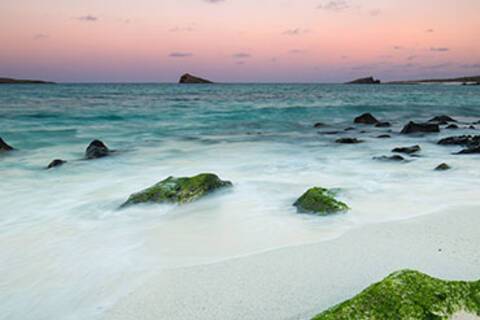
More than 560 miles from the coast of Ecuador, the Galápagos Islands are renowned for their extraordinary biodiversity. Discover some of the world’s rarest flora and fauna on a cruise here.
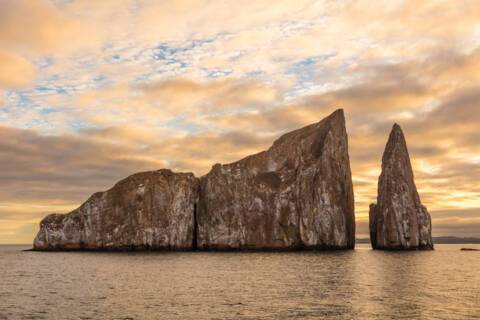

More than 560 miles from the coast of Ecuador, the Galápagos Islands are renowned for their extraordinary biodiversity. Discover some of the world’s rarest flora and fauna on a cruise here.
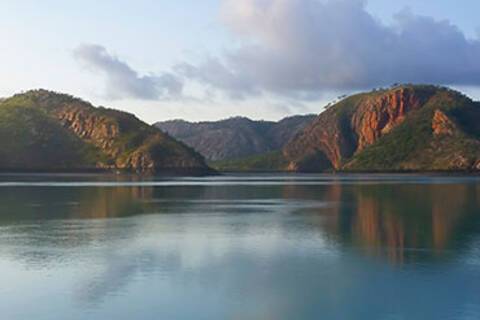
Nestled off the rugged coastline of Western Australia, the Buccaneer Archipelago stands as a rugged and untamed marine paradise.

More than 560 miles from the coast of Ecuador, the Galápagos Islands are renowned for their extraordinary biodiversity. Discover some of the world’s rarest flora and fauna on a cruise here.
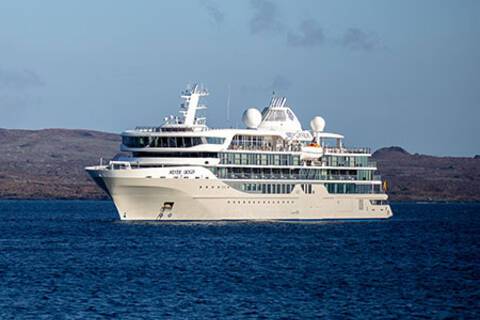

More than 560 miles from the coast of Ecuador, the Galápagos Islands are renowned for their extraordinary biodiversity. Discover some of the world’s rarest flora and fauna on a cruise here.

More than 560 miles from the coast of Ecuador, the Galápagos Islands are renowned for their extraordinary biodiversity. Discover some of the world’s rarest flora and fauna on a cruise here.
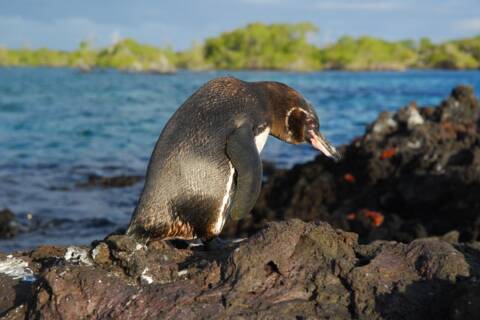
Elizabeth Bay is one of the marine sites on Isabela’s west coast. South of Alcedo Volcano and north of Sierra Negra, Elizabeth Bay is found at Isabela’s narrowest east-west extension where the lava flows of these two volcanoes have connected each other. Elizabeth Bay’s shores show mangroves and specifically the easternmost part, a cove which can only be entered via a narrow channel, has red, white and black mangroves. Different animals prefer different parts of Elizabeth Bay. Las Marielas, three rocks at the entrance to the bay, are favored by Blue-footed Boobies, Flightless Cormorants and Galapagos Penguins as a resting place, while the mangrove area is preferred by Great Blue Herons for hunting or the Magnificent Frigatebirds for perching. The bay is used by turtles, rays and even sharks for feeding or resting. The shallow water and the root system of the mangroves in the small inlet allow smaller fish to hide from bigger predators.
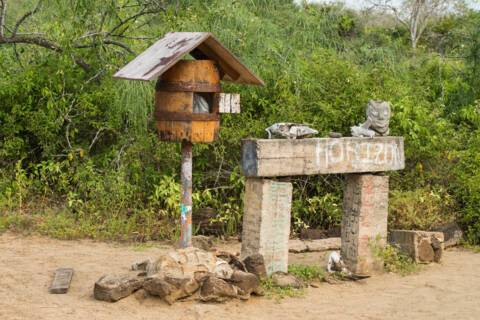
Floreana has been luring visitors since the 18th century when whalers hunted the island for tortoises and pirates sought shelter in its caves. Sailors established a rustic mailing system here: a barrel nailed to a pole where they would drop letters hoping they would be delivered by other mariners sailing home. Then take a walk along the lovely beach, or go snorkelling in an underwater world as colourful as Floreana’s history
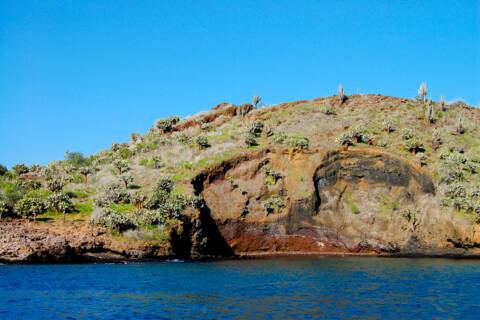
Champion Islet is a small islet some 700 meters off the northeast coast of Floreana. It is one of four marine sites surrounding Floreana and offers excellent deepwater snorkeling opportunities. Curious sea lions approach the snorkelers while turtles slowly swim by and sharks, sting rays, and a high diversity of colorful fishes can usually be seen. During a Zodiac cruise around Champion Islet not only seabirds such as Nazca Boobies, Swallow-tailed Gulls, or Red-billed Tropicbirds will be seen, it is also possible to spot the rare Floreana Mockingbird.
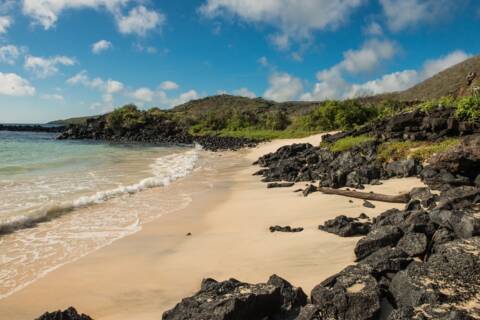
Where in the world can you see an olivine beach, deciduous vegetation and pink flamingos all in one place? Only at Punta Cormoránt, one of the most interesting sites in the islands. You’ll learn about the formation of beaches as we land on the olive-green sand and walk to Flour Beach, a favourite nesting site for Green Sea Turtles. Floreana also offers some of the best snorkelling sites in the Galápagos.
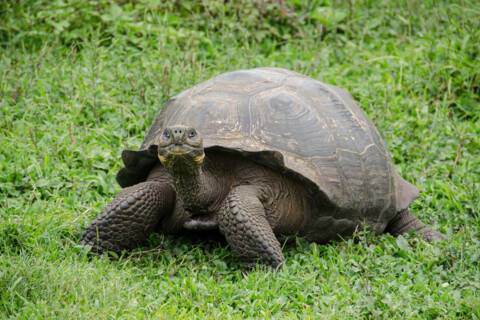
Los Gemelos (The Twins) is a visitor site in the Santa Cruz highlands. Found some 15 kilometers northwest of Puerto Ayora, the road leading from Puerto Ayora in the south of Santa Cruz to Itabaca in the north dissects the twin pit craters. Pit craters are formed when the roof of an underground void collapses. The smaller pit crater is on the eastern side of the road, while the larger one is on the western side. See from above, the two openings in the ground are not at all identical. View less Their layout might imply an elongated magma chamber or a lava tube leading further west and the larger twin actually having formerly been two small pit craters whose connecting wall collapsed as well. Trails through a Scalesia forest not only give access to good views of the pit craters, but also permit to observe some of the smaller land birds. Vermilion Flycatchers, Yellow Warblers, Galapagos Doves, Medium Ground Finches and several other finch species can often be seen there.

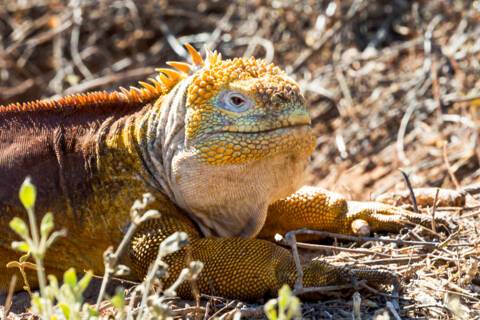
Cerro Dragón’s land iguanas once played an important part in a conservation program headed by the Charles Darwin Foundation and the Galapagos National Park. When the reptiles’ numbers declined in the 1970s, some animals were taken to breed in captivity and were released back into undeveloped areas. Today, it is an honor to see the success of this program firsthand at Cerro Dragón. Walk inland on a trail past small saltwater lagoons that periodically feature flamingos, to see the reintroduced animals. In a periodic local phenomenon, during rainier times the salinity in the lagoons drops with the inflow of freshwater. As a consequence crustacean populations decline, which in turn means the shorebirds become scarce.
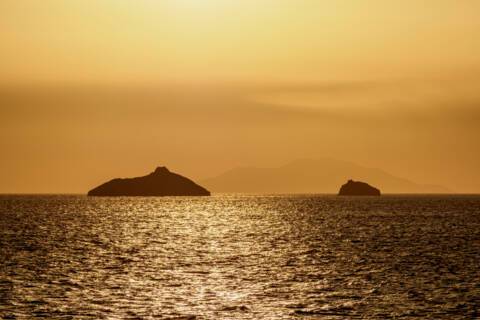


More than 560 miles from the coast of Ecuador, the Galápagos Islands are renowned for their extraordinary biodiversity. Discover some of the world’s rarest flora and fauna on a cruise here.


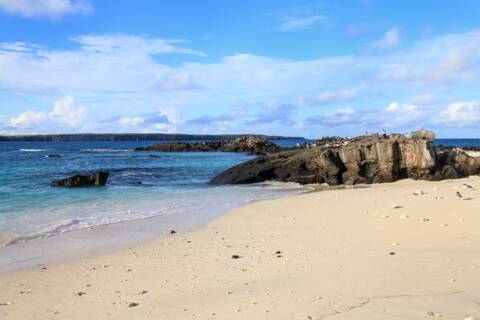
At Genovesa Island the ship tucks into Darwin Bay, an ancient volcanic crater now flooded by the sea. Zodiacs land on a picturesque sandy beach where Galapagos sea lions often rest on the fine, white sand. Explorations along the shore may reveal marine iguanas looking like prehistoric dinosaurs in miniature. By heading inland a short distance visitors could encounter seabirds of all shapes and sizes nesting in the vegetation. Scores of immature Red-footed Boobies perch on branches within an arm’s reach of the path. In addition, watch for Great Frigatebirds and Yellow-crowned Night Herons along the walk. There is also fantastic snorkeling in the waters of Darwin Bay with the opportunity to see large schools of reef fish and brightly colored sea stars.
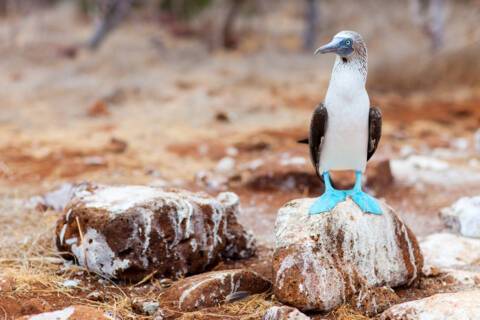
The landing at North Seymour Island is onto black lava rock. After a short climb, visitors arrive on the island’s flat plateau where a number of sea lions nurse pups and frigatebirds nest. The island is dry, and so the predominant tree is the prickly pear cactus favored by the yellow Conolophus land iguanas that live here in number. The undulating terrain is littered with red-brown volcanic boulders and large male Magnificent Frigatebirds can be seen inflating their vivid red gular sacs in hopes of impressing females flying overhead. View less At certain times of the year, pairs of Blue-footed Boobies dance here in a ritualized mating dance that reinforces their pair bond and shows off their vivid blue feet. The snorkeling here is well-known for schools of colorful creole wrasses and parrot fish.

More than 560 miles from the coast of Ecuador, the Galápagos Islands are renowned for their extraordinary biodiversity. Discover some of the world’s rarest flora and fauna on a cruise here.



Impressive Pahoehoe lava field that lies between two active volcanoes, Sierra Negra and Cerro Azul, on the south coast of Isabela Island. The rich waters of Cromwell current wash the shores, and as a result, you can see the largest marine iguanas of the archipelago basking on the rocks, flightless cormorants and Galapagos penguins diving for food. Snorkeling can be one of the coldest of the trip, but also one of the most rewarding experiences with good chances to see penguins “flying” underwater, Green Sea Turtles, and Marine Iguanas feeding. View less During the walk you will experience, as an oasis in a desert of lava, some coastal lagoons in the middle of the field, here you can find shorebirds such as White-cheeked Pintail Ducks, Black-necked Stilts and even sometimes Flamingos.

Los Gemelos (The Twins) is a visitor site in the Santa Cruz highlands. Found some 15 kilometers northwest of Puerto Ayora, the road leading from Puerto Ayora in the south of Santa Cruz to Itabaca in the north dissects the twin pit craters. Pit craters are formed when the roof of an underground void collapses. The smaller pit crater is on the eastern side of the road, while the larger one is on the western side. See from above, the two openings in the ground are not at all identical. View less Their layout might imply an elongated magma chamber or a lava tube leading further west and the larger twin actually having formerly been two small pit craters whose connecting wall collapsed as well. Trails through a Scalesia forest not only give access to good views of the pit craters, but also permit to observe some of the smaller land birds. Vermilion Flycatchers, Yellow Warblers, Galapagos Doves, Medium Ground Finches and several other finch species can often be seen there.

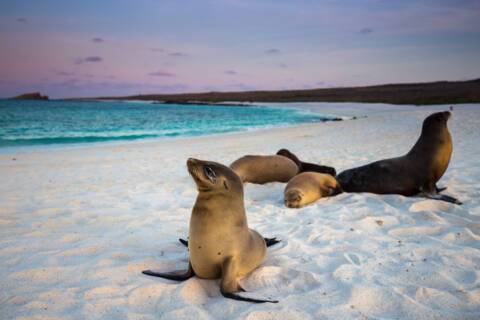
Isla Champion is a small islet off Floreana Island’s northeast coast. To cruise by it reveals a bare, rocky island without much allure, but to enter the infinitely blue waters around this small landmass is to discover a spectacular underwater realm. The visibility is generally impressive and thanks to this water clarity snorkelers often spot reef sharks patrolling the reef wall, cruising Pacific green turtles, and playful Galapagos sea lions. Encounters in the blue with thousands of small silver minnows, large tuna fish, or oceanic sunfish are not unheard of either.
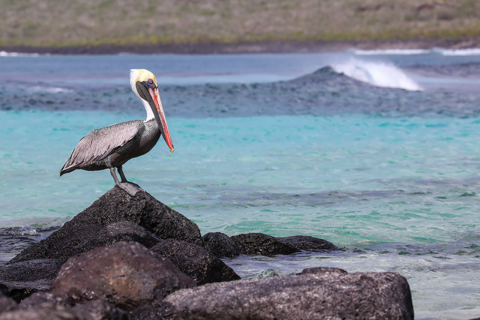
Punta Suárez lies at the western point of Española, the oldest island in the Galápagos. Sheer cliffs provide superb thermals for seabirds and you may spot Swallow-tailed Gulls, Nazca Boobies and Blue-footed Boobies on the breeze. The largest seabird to nest in the Galapagos Islands is the Waved Albatross. These ocean wanderers can be seen seasonally here from April through December, when pairs reunite on Española, going through an elaborate pair-bonding display. View less Mockingbirds, doves, and occasional Galápagos Hawks can also be seen on the point, along with sea lions and colorful marine iguanas.

More than 560 miles from the coast of Ecuador, the Galápagos Islands are renowned for their extraordinary biodiversity. Discover some of the world’s rarest flora and fauna on a cruise here.


More than 560 miles from the coast of Ecuador, the Galápagos Islands are renowned for their extraordinary biodiversity. Discover some of the world’s rarest flora and fauna on a cruise here.
View prices as:
Your current viewing preference is:
Per-Person Pricing
* Prices shown are per person, based on two adults sharing a twin cabin and include all cruise offer discounts and savings.

LOADING
| Deck | Price | Enquire | |
| CV | Deck 5 | Enquire now |
| Deck | Price | Enquire | |
| DX | Deck 6 | Enquire now |
| Deck | Price | Enquire | |
| GS | Deck 5 | Enquire now |
| Deck | Price | Enquire | |
| ME | Deck 6 | Enquire now |
| Deck | Price | Enquire | |
| OS | Deck 6 | Enquire now |
| Deck | Price | Enquire | |
| RS | Deck 5 | Enquire now |
| Deck | Price | Enquire | |
| SL | Deck 5 | Enquire now |
| Deck | Price | Enquire | |
| SV | Deck 6 | Enquire now |
| Deck | Price | Enquire | |
| G1 | Enquire now |
| Deck | Price | Enquire | |
| O1 | Enquire now |
| Deck | Price | Enquire | |
| R1 | Enquire now |
Purpose-built for the Galápagos Islands, Silver Origin is the most environmentally conscious ship in Silversea’s history and a true milestone in expedition cruising. Designed to host just 100 guests, she blends state-of-the-art technology with refined comfort, ensuring every journey through this extraordinary archipelago is both immersive and indulgent. Her all-suite accommodation features Horizon Balconies and butler service, while elegant interiors echo the natural beauty of the islands outside. Expert-led expeditions, Zodiac landings and guided snorkelling adventures offer unparalleled opportunities to encounter wildlife up close, while onboard spaces like Basecamp and the Explorer Lounge create seamless transitions between discovery and relaxation. With world-class Ecuadorian-inspired cuisine, exceptional service and a deep respect for the environment, Silver Origin redefines luxury exploration, offering an experience as enriching as the destination itself.
What’s onboard: 100 guests, 51 guest suites, two activities, two complimentary restaurants, two bars and lounges, three relaxation and fitness venues, and two essential venues.
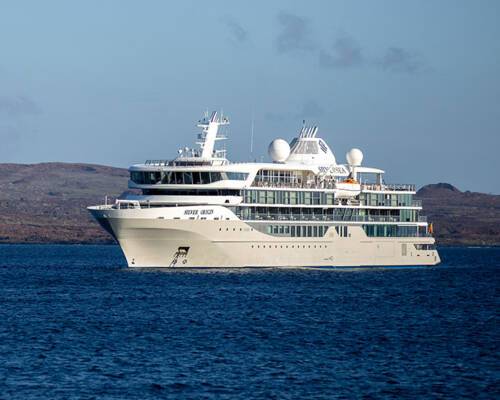
Yes, all Silversea ships are equipped to offer Wi-Fi access.
At Silversea, the comfort, enjoyment and safety of all guests is paramount. Most areas onboard are non-smoking and, as a safety precaution, smoking is not permitted in guest accommodations. However, smoking is permitted in the Connoisseur’s Corner and in specifically designated areas.
Yes, guests can take alcohol on their Silversea cruise. There are no limitations.
Gratuities are included in the price of your Silversea cruise.
The currency used onboard Silversea is US Dollars.
Shipboard attire ranges from casual to formal. Casual wear is appropriate for daytime aboard the ship or ashore and consists of standard sports outfits as worn at 5-star resorts. Evening attire falls into 3 categories; casual, informal and formal.
Shore excursions are available to book in advance via My Silversea until 2 days prior to sailing.
John Lewis Gift Card is based on one per booking, for UK mainland addresses only when booking an Oceanview or above by 8pm 31st October 2025. The amount is tiered on cabin grade booked.
View ROL Cruise Payment Methods HERE